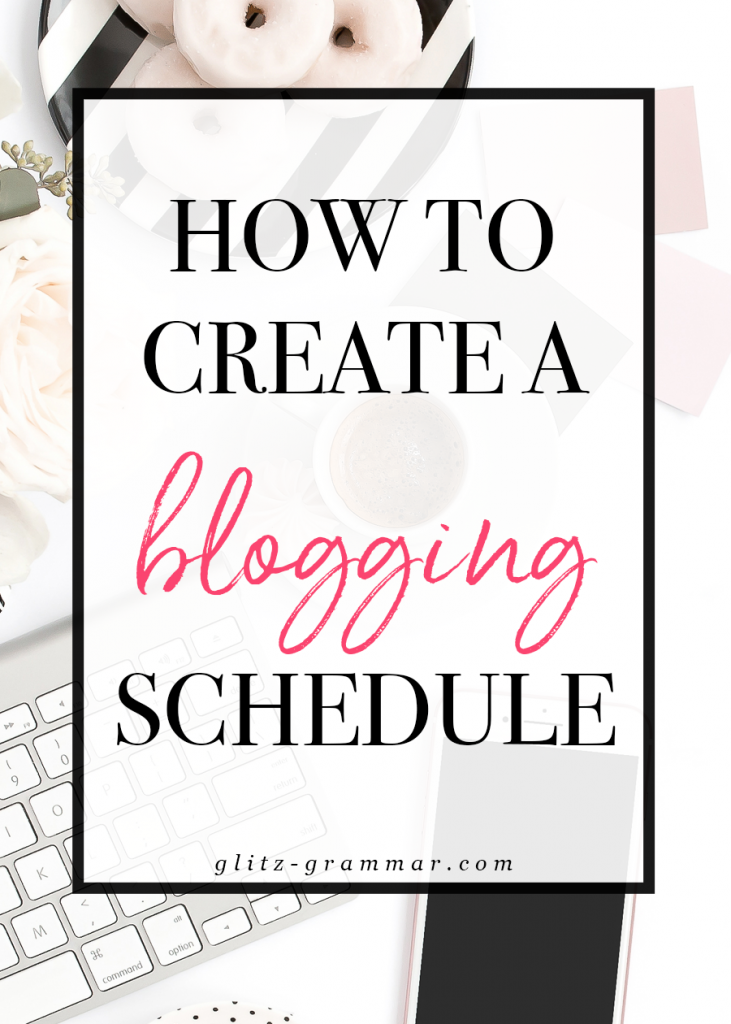How to Create a Blogging Schedule + FREE Blog Schedule Templates
Let me guess: you’re not as consistent as you’d like to be with your content. What you need is a realistic blogging schedule that’s attainable and will help you reach your goals!

I assume you mean a daily blogging schedule more so than an editorial calendar. If it is the latter, check out this post on how to create an editorial calendar. It includes a free editorial calendar template for you + the tips I use when creating editorial calendars for my clients.
But, back to the blogging schedule and the sample blogging schedule I’ve created for you here.
It’s a crucial piece of your business because consistency is truly key to engagement and growth.
In fact:
Folks who publish consistent content get as much as 30% more traffic for every post they publish, all while saving about an hour per post,”–CoSchedule
Now that’s something worth working on, wouldn’t you say?
Put simply, a blogging schedule:
- Helps keep you organized
- Creates built-in consistency
- Helps keep you sane while juggling 1,000 things
Your blogging schedule will look different if you’re a part-time blogger vs. full-time blogger. I’m going to assume you’re the former, or at least a business owner who has a blog, so you need to do your content marketing on a part-time basis while either juggling clients or your full-time job.
The Three Steps to Creating a Blogging Schedule that Works
Step 1: Assess your goals
What are your content marketing goals? You should decide and commit to a certain number of posts per week or month that’s realistic to where you’re at in your business or blogging journey. This will drive the entire schedule.
Not sure where to start? I recommend 1 post per week or 2 per month if you’re just starting.
RELATED: How to Start a Blog in 2021
If this is your first time setting goals for your blog, check out this post on how to set goals as a blogger. It has specific examples of the blog post types and daily tasks you should be focusing on to help you reach your goals.
Step 2: Batch your blogging tasks
Some people are of the mindset that you need to be writing everyday. Between blog posts, emails, email marketing, social media, etc. you’re pretty much writing everyday anyway so there’s no need to be working on your blog posts daily.
Instead, you should create a blogging schedule that allows you to batch your blog posts. I have an entire post that talks about how to batch your blogging tasks so that you are more focused and can make more progress with your posts.
A sample blogging schedule with blog posts batched might look like:
- Week 1: Keyword research
- Week 2: Outline + start drafting posts
- Week 3: Writing & editing
- Week 4: Format, upload, graphic design
It takes SO much more time to constantly switch gears when you’re writing one minute and then creating graphics the next. When you batch your tasks, you’re able to create a blogging schedule that’s laser-focused and frees up brain time for other tasks.
You won’t spend week 2 brainstorming blog post ideas because you already did that in week 1. So you’ll never have to sit down at the computer and wonder what to write about.
Find this whole thing overwhelming? I create content marketing plans for my clients and can help you too. Learn more here.
Step 3: Create Your Perfect Blogging Schedule
So how do you create a blog schedule? Everyone’s ideal blogging schedule is going to look different because some juggle clients, some juggle full-time jobs and some are night owls or getting up at 5 a.m. for yoga (kudos to you).
Regardless, a solid blogging schedules helps keep you on track and consistent!
The above sample blog schedulesis broken down with your blog tasks on a weekly basis. This is ideal if you’re planning on tackling your blog posts an entire quarter at a time. Yes, I said create three months of blog content at once, in a month or less. This way, if you’re having a big launch or doing heavy client work you have all that free time in your schedule to focus on just that and all of your blog posts are already scheduled.
Another way people like to structure their blogging schedule is on a daily basis. Here is a sample part-time blogging schedule you can try:
- Marketing Mondays (schedule all social media for the week) respond to comments, emails, Pinterest, etc.
- Tuesday: Outline your blog post and start writing
- Wednesday: Writing & editing blog post continued
- Thursday: graphic creation for Pinterest & social media, look for stock photos, take photos
- Friday: Upload your post, format, finances and admin
- Repeat weekly
Notice how I left out brainstorming and SEO research for this blogging schedule template. I want you to do this on a bulk day and plan out quarterly content calendars so this isn’t a weekly task.
I block out a week once a quarter to do this after having taken Mike Pearson’s Stupid Simple Seo. This doesn’t mean I don’t make room for on-the-fly blog post ideas; what I do is keep them in a Trello board when they come to me, keep working and then research them further later.

I use the editorial calendar Trello board I got from Kate Doster. It’s AMAZEBALLS. Yes, I said that. I mean it. And it’s one way I stay organized as a blogger.
More Tips to Stick to a Blogging Schedule
What about client projects? Zoom calls, etc.? I recommend slotting these into specific days. And, you guessed it, it is NOT your writing days. You want your time completely blocked out, email and notifications off for when you’re writing so you can just focus and get it done.
For more writing tips for bloggers, join my FREE Facebook group here.
If you’re pitching, schedule it out on a day when you’re doing admin type work.
Bottom line: you need to keep your writing days sacred. Because they are.
When you’re writing, just write. This means:
- Don’t go looking for photos for your post until your first draft is done
- Don’t grab links until your first draft is done
- Don’t upload and format your post until your first draft is done
- Don’t do literally anything else, until that first draft is done
All of this will help create momentum, get you into the writing groove so you’re writing your blog posts faster.
And that’s what we want, right? Consistency, efficiency and a content marketing machine that doesn’t have you pulling your hair out on what to do next or when.
I hope you found those sample blogging schedules helpful! Let me know in the comments below if you have a blogging schedule and what that looks like for you.







Wow there are SO many helpful tips and tricks in this article. I’m actually a bit excited to get started now. Will definitely be trying the working in batches technique!
So glad you found it helpful, Kate!